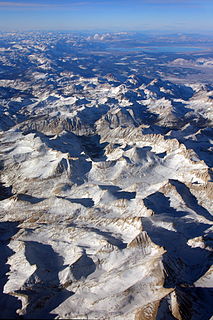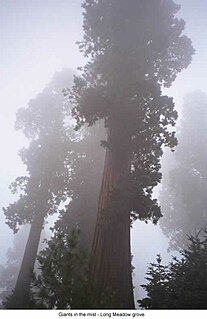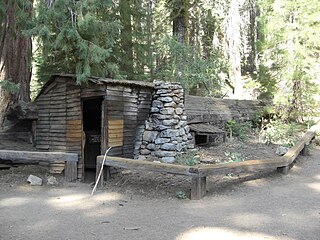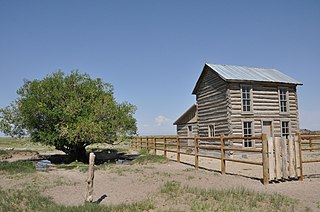
Hale Dixon Tharp was a miner during the California Gold Rush, and the first non-Native American settler to enter Giant Forest, in what is now Sequoia National Park.

Hale Dixon Tharp was a miner during the California Gold Rush, and the first non-Native American settler to enter Giant Forest, in what is now Sequoia National Park.
Tharp was born in Michigan in 1828. In 1851, a widow from Illinois, Chloe Ann Smith Swanson, hired Tharp to take her and her four sons to California in a covered wagon with two teams of oxen. They settled in Placerville, where Tharp married Swanson. [1] Tharp then began mining in California's Gold Country. [2]
In the summer of 1856, Tharp went to Tulare County to establish a preemption homestead, with the intent to return later to ranch cattle. He built a shake and brush shack near the confluence of the Kaweah River and Horse Creek, east of Visalia and south of Three Rivers. He then returned to Placerville. [2]
Two years later, Tharp, along with his brother-in-law John Swanson, returned to his homestead and built a log cabin and barn, Cattle Cabin. Tharp then sought cattle summer pasturage. Led by the local Yokut Indians, Tharp "discovered" Crescent Meadow and Log Meadow near the Giant Forest. He claimed grazing rights there for several years. [2]
Tharp's Log is a home Tharp built in a hollowed Giant sequoia (Sequoiadendron gigantuem) log at Log Meadow. It is restored and visited by tourists in Sequoia National Park today, and is on the National Register of Historic Places.
Hale Tharp, along with stepsons George and John Swanson, were the first non-Native American settlers known to ascend the granite dome Moro Rock. [3]

The Sierra Nevada is a mountain range in the Western United States, between the Central Valley of California and the Great Basin. The vast majority of the range lies in the state of California, although the Carson Range spur lies primarily in Nevada. The Sierra Nevada is part of the American Cordillera, an almost continuous chain of mountain ranges that forms the western "backbone" of the Americas.

Kings Canyon National Park is an American national park in the southern Sierra Nevada, in Fresno and Tulare Counties, California. Originally established in 1890 as General Grant National Park, the park was greatly expanded and renamed to Kings Canyon National Park on March 4, 1940. The park's namesake, Kings Canyon, is a rugged glacier-carved valley more than a mile (1,600 m) deep. Other natural features include multiple 14,000-foot (4,300 m) peaks, high mountain meadows, swift-flowing rivers, and some of the world's largest stands of giant sequoia trees. Kings Canyon is north of and contiguous with Sequoia National Park, and both parks are jointly administered by the National Park Service as the Sequoia and Kings Canyon National Parks.

Sequoia National Park is an American national park in the southern Sierra Nevada east of Visalia, California. The park was established on September 25, 1890 to protect 404,064 acres of forested mountainous terrain. Encompassing a vertical relief of nearly 13,000 feet (4,000 m), the park contains the highest point in the contiguous United States, Mount Whitney, at 14,505 feet (4,421 m) above sea level. The park is south of, and contiguous with, Kings Canyon National Park; both parks are administered by the National Park Service together as the Sequoia and Kings Canyon National Parks. UNESCO designated the areas as Sequoia-Kings Canyon Biosphere Reserve in 1976.

Calaveras Big Trees State Park is a state park of California, United States, preserving two groves of giant sequoia trees. It is located 4 miles (6.4 km) northeast of Arnold, California in the middle elevations of the Sierra Nevada. It has been a major tourist attraction since 1852, when the existence of the trees was first widely reported, and is considered the longest continuously operated tourist facility in California.

General Grant Grove, a section of the greater Kings Canyon National Park, was established by the US Congress in 1890 and is located in Fresno County, California. The primary attraction of General Grant Grove is the giant sequoia trees that populate the grove. General Grant Grove's most well-known tree is the General Grant Tree, which is 267 feet tall and the third largest known tree in the world. The General Grant Tree is over 1,500 years old and is known as the United States's national Christmas Tree. General Grant Grove consists of 154 acres and is geographically isolated from the rest of Kings Canyon National Park.

Human habitation in the Sierra Nevada region of California reaches back 8,000 to 10,000 years ago. Historically attested Native American populations, such as the Sierra Miwok, Mono and Paiute, belong to the Uto-Aztecan and Utian phyla. In the mid-19th century, a band of Native Americans called the Ahwahnechee lived in Yosemite Valley. The California Gold Rush greatly increased the number of non-indigenous people in the region. Tensions between Native Americans and white settlers escalated into the Mariposa War. As part of this conflict, settler James Savage led the Mariposa Battalion into Yosemite Valley in 1851, in pursuit of Ahwaneechees led by Chief Tenaya. The California state military forces burned the tribe's villages, destroyed their food stores, killed the chief's sons, and forced the tribe out of Yosemite. Accounts from the Mariposa Battalion, especially from Dr. Lafayette Bunnell, popularized Yosemite Valley as a scenic wonder.

Sequoia National Forest is located in the southern Sierra Nevada mountains of California. The U.S. National Forest is named for the majestic Giant Sequoia trees which populate 38 distinct groves within the boundaries of the forest.

Mineral King is a subalpine glacial valley located in the southern part of Sequoia National Park, in the U.S. state of California. The valley lies at the headwaters of the East Fork of the Kaweah River, which rises at the eastern part of the valley and flows northwest. Accessed by a long and narrow winding road, the valley is mostly popular with backpackers and hikers.

The Kaweah River is a river draining the southern Sierra Nevada in Tulare County, California in the United States. Fed primarily by high elevation snowmelt along the Great Western Divide, the Kaweah begins as four forks in Sequoia National Park, where the watershed is noted for its alpine scenery and its dense concentrations of giant sequoias, the largest trees on Earth. It then flows in a southwest direction to Lake Kaweah – the only major reservoir on the river – and into the San Joaquin Valley, where it diverges into multiple channels across an alluvial plain around Visalia. With its Middle Fork headwaters starting at almost 13,000 feet (4,000 m) above sea level, the river has a vertical drop of nearly two and a half miles (4.0 km) on its short run to the San Joaquin Valley, making it one of the steepest river drainages in the United States. Although the main stem of the Kaweah is only 33.6 miles (54.1 km) long, its total length including headwaters and lower branches is nearly 100 miles (160 km).

The Giant Forest, famed for its giant sequoia trees, is within the United States' Sequoia National Park. This montane forest, situated at over 6,000 ft (1,800 m) above mean sea level in the western Sierra Nevada of California, covers an area of 1,880 acres (7.6 km2). The Giant Forest is the most accessible of all giant sequoia groves, as it has over 40 mi (64 km) of hiking trails.

Caburgua Lake is located 23 km northeast of the city of Pucón, in the La Araucanía Region of Chile. Huerquehue National Park lies to the east of the lake. Like Villarrica Lake, it is part of Toltén River basin. During summer the outflow river may dry out but due to high levels of underground infiltration the waterfalls Ojos del Caburgua never run dry.

Tharp's Log is a hollowed giant sequoia log at Log Meadow in the Giant Forest grove of Sequoia National Park that was used as a shelter by early pioneers. The log is named after Hale D. Tharp, who was described as the first Non-Native American to enter the Giant Forest.

The Cattle Cabin is a one-room log cabin that was built in the Sierra Nevada by Hale D. Tharp and two partners in 1890, in present-day Sequoia National Park, California.

Hospital Rock is a large quartzite rock in Sequoia National Park, located just off of the Generals Highway, on the Middle Fork of the Kaweah River.

Alta Peak is in Sequoia National Park not far from Giant Forest. Before 1896, the mountain was known as Tharps Peak. By 1903 it was generally known by its current name and Alta Peak appears on the Tehipite quadrangle, USGS 30 minute topographic map of 1905, and was officially recognized by the Board on Geographic Names in 1928. The Sierra Club Bulletin noted that the name Alta Peak was "euphonious". A meadow on its southern slope had long been known as Alta Meadow. A rocky outcrop, 0.5 miles (0.8 km) southwest of the summit, is now known as Tharps Rock. Hale Tharp was the first euro-American to explore the Giant Forest area. His summer camp, a hollowed out Sequoia log near Crescent Meadow known as Tharp's Log, is popular with park visitors.

Silver City is a census-designated place (CDP) in the mountainous area of central Tulare County, California. Silver City sits at an elevation of 6,732 feet (2,052 m). It lies 72 km ENE of Visalia, California, within the boundary of Sequoia National Park. The 2010 United States census reported Silver City was uninhabited.

The High Sierra Camps are nine rustic lodging facilities located in two national parks and a national monument in California's Sierra Nevada mountain range. Open most years from June or July to September, they are staffed camps with tent cabins and food service facilities. The backcountry camps receive their supplies by pack mules.

The Trujillo Homesteads are a historic ranch site near Mosca, Alamosa County, Colorado, not far from the Great Sand Dunes National Park. The area was first settled in the 1860s by Teofilo Trujillo, a Mexican sheep farmer. His son Pedro built a log cabin house beginning in 1879, along with other ranch outbuildings and structures. In 1902 the elder Trujillo's home was destroyed by fire during conflicts between English-speaking cattle ranchers and the Spanish Trujillos, who were by then major landowners in the area. The Trujillos sold their holdings, which became part the Medeno Zapata Ranch, now owned by the Nature Conservancy. The homestead area, including the surviving homestead and the ruins of the destroyed one, was declared a National Historic Landmark District in February 2012.

The Pioneer Cabin Tree, also known as The Tunnel Tree, was a giant sequoia in Calaveras Big Trees State Park, California. It was considered one of the U.S.'s most famous trees, and drew thousands of visitors annually. It was estimated to have been more than 1,000 years old, and measured 33 feet (10 m) in diameter; its exact age and height were not known. The tree was topped before 1859. It fell and shattered during a storm on January 8, 2017.
Mountain Home Demonstration State Forest (MHDSF) is a state forest located on Bear Creek Road, 28 km (17 mi) northeast of Springville in Tulare County, California. The protected land covers an area of 4,807 acres (19 km2) with an elevation range between 1,463 m (4,800 ft) and 2,377.5 m (7,800 ft). The forest is best known for its namesake giant sequoia grove, Mountain Home Grove, which is home to some of the largest giant sequoias in the world.